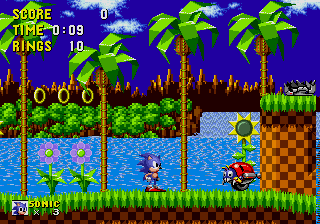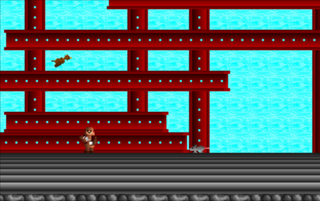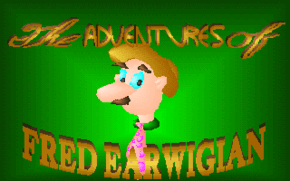SR388: A Spelunker’s Nightmare
[ The following post is assembled from fragments of discussion from July 2014, October 2014, July 2016, and August 2017. ]
Long before that AM2R thing, which is exactly what a cynical observer would predict from a fan remake, I’ve often rambled about ways to do a sensitive update of Metroid II, that (unlike AM2R) honors the original game’s tone and thematic material and develops it even further, makes the game even more awkward and upsetting to play:
I still think the best way to tackle a remake is to consider the affect of the original, and try to recreate it. The original is claustrophobic, in part due to feeling lost — sameness, lack of a map — in part to the screen.
So, make light a scarce quantity. The world would be desaturated and have a big focus on environmental light sources — lava, certain bioluminescent plants or animals, Chozo technology. At times it’s hard to see anything. Sort of a Silent Hill aspect.
Samus’s suit may project a slight glow around her, reflecting on things. Generally the glow would extend about as far as the boundaries of the GB screen. Occasionally more or less. The glow from Samus’ suit would give things a sort of monotone hue. Maybe greenish, from her visor.
If you wanted to expand on the game, you could give her various kinds of light beam. Or make her suit glitch out. Maybe special heat and X-ray visors would be needed to navigate certain areas. Glitchily. It would be all grainy and prone to error. Make it go totally dark, for a scripted segment here or there, in the spirit of those segments where you have to blindly fumble around in ball form. Maybe you have to navigate by noise and touch. Maybe a sort of a sonar, so you can hear when the Metroids are getting close.
There might be an attempt at a map, but it doesn’t work right. Glitchy. Staticky. Suggests non-Euclidean space. Some key parts of the interior may not make any sort of euclidean geometric sense. They kind of don’t, already.
This would also play up some of the Zelda-style risk-and-reward progress limitation. You CAN go down there, but… should you?
Also see: Dragon Warrior, Phantasy Star II, Lost in Blue.
But, that’s if I were pressed to reinterpret the game. Insofar as its native form on the Game Boy, Metroid II is basically perfect. The worst I can say is that the control can get a little mushy at times. Speed up Samus’ movement by 125%, maybe tighten collision and response time. Little stuff like that.
Something I really dig about Metroid II is that as designed, it wouldn’t really make as much sense on another console. If you play through as an adult, with a modicum of design literacy in hand, it soon becomes clear to what extent the game actively uses its technical and conceptual limitations to say its own thing.
Unlike Super Metroid the world that it draws doesn’t feel like a playground set up for your benefit. It’s just there. If it’s confusing, then it would be, wouldn’t it. You’re invading this space that was never meant for a thing like you.
The game’s affect is just so subjective.The way the Spider Ball is used nails down how unfriendly the space is. This is a space where we really shouldn’t be, and it’s just by the skin of this overpowered miraculous thing that it works.
When you get to the cramped corridor forcing you to draw a visual parallel between Samus in ball form and the unhatched Metroid egg, there’s not a lot of space left (as it were) to question how expressive the design is meant to be.
It’s supposed to be claustrophobic. It’s meant to be disorienting and upsetting. You’re supposed to lose your way and freak out, the way you probably would in reality if you were dropped into an unmapped hole in the ground on an alien world. Or even ours. Even if mapped. It’s meant to be distressing, in no small part because you shouldn’t be there. The mission is wrong. You are playing the bad guy.
That’s not reading into it. In its closing moments the game tells you how you messed up, and Fusion‘s plot is based on this revelation. (Another irritating thing about Super Metroid is how it not only glosses over this failing; it compounds it. But Fusion gets the story back.) Fusion also gets the claustrophobia and tension back, in a shifted form, where Super throws them out in favor of Whee Shiny Perfect Action.
As far as how Metroid II uses the resources it has, the only thing I would treat differently is the lava. To quote one of many earlier discussions on the topic,
That goddamned lava. What is that? Of all the ways to limit progress. I mean… I can make up some silly theories that kind of work. But how arbitrary is that? At least it’s an apparent phenomenon of the gameworld, even if it’s triggered by discrete player-dependent flags.
Instead of progress clearly resulting from the player’s action it’s just, “What the hell was that rumble? Oh… there’s… a route here. Was it here before? I don’t think so.” Granted, it doesn’t affect me when I’m playing. It’s just in retrospect that it’s so incredibly clumsy and weird.
Of course the game is pretty linear, and it can’t let you miss a Metroid. If there were some narrative rationalization, maybe that would be enough. But then you’re in danger of needless exposition.
On reflection, I would add a horrible piercing screech after the extermination of each set of Metroids and before the earthquake and lava drain. Each time, as Samus strayed deeper into the caverns, the screech would get louder and longer, while the screen would shake with ramping violence. Toward the end, it basically would peak all of the sound output and leave the game a nauseating shaky-cam mess for minutes at a time.
This would serve many purposes.
- It would make the game more disorienting and upsetting to play.
- It would introduce the Queen early as Samus’s opponent.
- It would establish the Queen’s growing pain and anger.
- It would help to underline that maybe Samus isn’t quite doing the right thing here.
- And it would resolve the structural weirdness around the lava, which as it stands is a VERY CONVENIENT and unexplained progress limiter.
All of this would be totally doable on the Game Boy. Pretty easy, even, in this engine. Everything’s already set up, pretty much. Just add a screech that gets louder and longer each time, and make the screen rumble longer and more violent each time. That’s all! But, it would make such a big difference to the game’s narrative flow, logical consistency, and thematic unity.
Would this change be on-the-nose, in terms of the game’s themes? Maybe. But done well, it wouldn’t be clear what was happening at first. It’d just add a layer of “huh?”, growing to “oh hell.”
Right now there’s little feedback to completing each wave, and the mild rumble has little impact, the lava drain nothing like an explanation. This would add at least a sense of intentionality to the design, which as designed leaves room for interpretation, yes, but also feels sloppy.
Significantly, all of the scream’s and the rumble’ thematic resonance becomes clear only in retrospect. You get ramping uncomfortable chaos as you burrow in, but aside from feeling increasingly intimidated, it’s only clear what’s happening when you finally meet the Queen, which snaps it all into focus.
Currently there is no clear moment of epiphany, and the Queen’s role consists of sitting there, unseen, until you burst in and kill her. The epiphany comes with the egg, which is great. Really great, actually. But its significance would be enhanced, coming out of the catharsis of that encounter with the thing that had been expressing pain the whole time. “Oh hell,” you’d think, “so that’s what has been happening all along. What… does all of this mean? What have I done?” And then, a baby Metroid imprints on you.
You’re still free to interpret however you like, but this gives a touch of emotional feedback and clarity to undermine any sense of bravado. And all it is is a screech and a more violent screen shake. That’s all it takes to snap it all into focus.
























